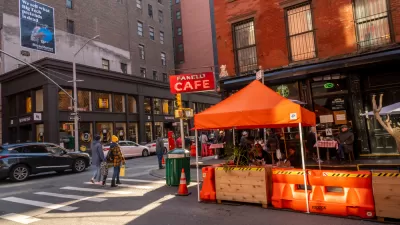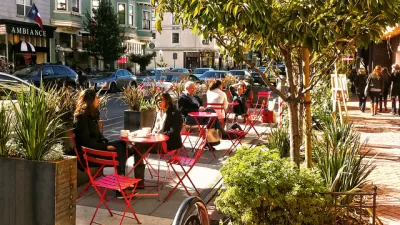The social and economic upheaval of the last two years accelerated a shift in thinking about how we use public space and organize the urban realm.

After decades of glacial progress on shifting public space away from a focus on cars, the disruption brought on by COVID-19 led to a radical rethinking of how we use roads and sidewalks. As Adam Rogers writes,
The virus—and specifically the understanding that as an aerosol it spread more easily in poorly ventilated spaces—changed something fundamental about urban life. The expansion of restaurants to curbside spaces and the closure of city streets to automobiles began in 2020, but in 2021 those alterations felt like a new phase in a decades-old cold war over the look and feel of the modern city.
Although the pandemic also halted progress that cities were making on increasing density and boosting public transit use, Rogers writes, the focus on social distancing and access to the outdoors brought a new urgency to reinventing the right-of-way for more people-oriented uses and encouraging walkable, bikeable neighborhoods. But this hasn't come without its own challenges: as cities scramble to create new regulatory frameworks for pandemic-era projects, the process often becomes onerous and expensive for small businesses and organizations. Meanwhile, disability advocates caution that some parklets impede access for wheelchairs, and public space proponents criticize dining setups for using public right-of-way for private businesses.
Nevertheless, Rogers concludes optimistically, "this new image of the city offers a sense of possibility—of hope, even—in the fight against climate change and inequality."
FULL STORY: The Pandemic Might Have Redesigned Cities Forever

Planetizen Federal Action Tracker
A weekly monitor of how Trump’s orders and actions are impacting planners and planning in America.

Congressman Proposes Bill to Rename DC Metro “Trump Train”
The Make Autorail Great Again Act would withhold federal funding to the system until the Washington Metropolitan Area Transit Authority (WMATA), rebrands as the Washington Metropolitan Authority for Greater Access (WMAGA).

The Simple Legislative Tool Transforming Vacant Downtowns
In California, Michigan and Georgia, an easy win is bringing dollars — and delight — back to city centers.

The States Losing Rural Delivery Rooms at an Alarming Pace
In some states, as few as 9% of rural hospitals still deliver babies. As a result, rising pre-term births, no adequate pre-term care and harrowing close calls are a growing reality.

The Small South Asian Republic Going all in on EVs
Thanks to one simple policy change less than five years ago, 65% of new cars in this Himalayan country are now electric.

DC Backpedals on Bike Lane Protection, Swaps Barriers for Paint
Citing aesthetic concerns, the city is removing the concrete barriers and flexposts that once separated Arizona Avenue cyclists from motor vehicles.
Urban Design for Planners 1: Software Tools
This six-course series explores essential urban design concepts using open source software and equips planners with the tools they need to participate fully in the urban design process.
Planning for Universal Design
Learn the tools for implementing Universal Design in planning regulations.
Smith Gee Studio
City of Charlotte
City of Camden Redevelopment Agency
City of Astoria
Transportation Research & Education Center (TREC) at Portland State University
US High Speed Rail Association
City of Camden Redevelopment Agency
Municipality of Princeton (NJ)




























